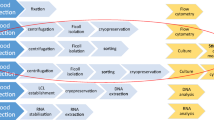Abstract
Background Interest in the biology of endogenous progenitor cells (EPCs) continues to grow as evidence of their role in vascular repair mounts. EPC enumeration requires specialized laboratory techniques and is performed immediately after sample acquisition, limiting the clinical contexts in which EPC enumeration can be performed and the ability to increase sample sizes through multi-center participation. Methods We compared the numbers of EPCs enumerated in samples processed immediately after acquisition (n = 36) with EPCs enumerated in specimens stored for 24 hours or after cryopreservation of mononuclear cells (MNC) using two EPC identification strategies: cell surface marker expression (CD133/CD34) and aldehyde dehydrogenase activity (ALDHbr cells). Results EPCs assessed in fresh samples correlated with EPCs enumerated after whole blood storage (r = 0.699 for CD133+CD34+ cells, r = 0.880 for ALDHbr cells, P < 0.005 and P < 0.0001, respectively) or mononuclear cryopreservation (r = 0.590 for CD133+CD34+ cells, r = 0.894 for ALDHbr cells, P < 0.0001 for each); however, correlation based on assessment of ALDHbr cells was higher (P < 0.0003 for comparison of correlation coefficients). Initial results from a multi-site clinical trial suggest that EPC enumeration after mononuclear cell cryopreservation is feasible. Conclusion EPC analysis based on ALDH activity is reproducible, even after extended whole blood storage or MNC cryopreservation.





Similar content being viewed by others
References
Schmidt-Lucke C, Rossig L, Fichtlscherer S et al (2005) Reduced number of circulating endothelial progenitor cells predicts future cardiovascular events: proof of concept for the clinical importance of endogenous vascular repair. Circulation 111:2981–2987. doi:10.1161/CIRCULATIONAHA.104.504340
Werner N, Kosiol S, Schiegl T et al (2005) Circulating endothelial progenitor cells and cardiovascular outcomes. N Engl J Med 353:999–1007. doi:10.1056/NEJMoa043814
George J, Goldstein E, Abashidze A et al (2005) Erythropoietin promotes endothelial progenitor cell proliferative and adhesive properties in a pi 3-kinase-dependent manner. Cardiovasc Res 68:299–306. doi:10.1016/j.cardiores.2005.06.022
Prunier F, Pfister O, Hadri L et al (2007) Delayed erythropoietin therapy reduces post-mi cardiac remodeling only at a dose that mobilizes endothelial progenitor cells. Am J Physiol Heart Circ Physiol 292:H522–H529. doi:10.1152/ajpheart.00357.2006
Zen K, Okigaki M, Hosokawa Y et al (2006) Myocardium-targeted delivery of endothelial progenitor cells by ultrasound-mediated microbubble destruction improves cardiac function via an angiogenic response. J Mol Cell Cardiol 40:799–809. doi:10.1016/j.yjmcc.2006.03.012
Hill JM, Zalos G, Halcox JPJ et al (2003) Circulating endothelial progenitor cells, vascular function, and cardiovascular risk. N Engl J Med 348:593–600. doi:10.1056/NEJMoa022287
Vasa M, Fichtlscherer S, Aicher A et al (2001) Number and migratory activity of circulating endothelial progenitor cells inversely correlate with risk factors for coronary artery disease. Circ Res 89:e1–e7. doi:10.1161/hh1301.093953
Scheubel RJ, Zorn H, Silber R-E et al (2003) Age-dependent depression in circulating endothelial progenitor cells in patients undergoing coronary artery bypass grafting. J Am Coll Cardiol 42:2073–2080. doi:10.1016/j.jacc.2003.07.025
Povsic T, Zavodni K, Kelly F et al (2007) Circulating endogenous progenitor cells can be reliably identified on the basis of aldehyde dehydrogenase activity. J Am Coll Cardiol 53:2243–2248. doi:10.1016/j.jacc.2007.08.033
Povsic T, Zavodni K, Vainorius E, et al. (2008) Common endothelial progenitor cell assays identify discrete epc populations. Am Heart J. doi:10.1016/j.ahj.2008.10.010
Gentry T, Foster S, Winstead L et al (2007) Simultaneous isolation of human bm hematopoietic, endothelial and mesenchymal progenitor cells by flow sorting based on aldehyde dehydrogenase activity: implications for cell therapy. Cytotherapy 9:259–274. doi:10.1080/14653240701218516
Nagano M, Yamashita T, Hamada H et al (2007) Identification of functional endothelial progenitor cells suitable for the treatment of ischemic tissue using human umbilical cord blood. Blood 110:151–160. doi:10.1182/blood-2006-10-047092
Duckers H, Silber S, de Winter R et al (2007) Circulating endothelial progenitor cells predict angiographic and intravascular ultrasound outcome following percutaneous coronary interventions in the healing-ii trial: evaluation of an endothelial progenitor cell capturing stent. EuroIntervention 3:67–75
Acknowledgements
This study was funded in part by National Heart, Lung, and Blood Institute grant K-18 HL081419-01A1 (TJP), a Society of Geriatric Cardiology Merck Geriatric Cardiology Research Award (TJP), and a grant from the Duke Clinical Research Institute (TJP).
Author information
Authors and Affiliations
Corresponding author
Electronic supplementary material
Below is the link to the electronic supplementary material.
Rights and permissions
About this article
Cite this article
Povsic, T.J., Adams, S.D., Zavodni, K.L. et al. Aldehyde dehydrogenase activity allows reliable EPC enumeration in stored peripheral blood samples. J Thromb Thrombolysis 28, 259–265 (2009). https://doi.org/10.1007/s11239-009-0306-6
Received:
Accepted:
Published:
Issue Date:
DOI: https://doi.org/10.1007/s11239-009-0306-6




